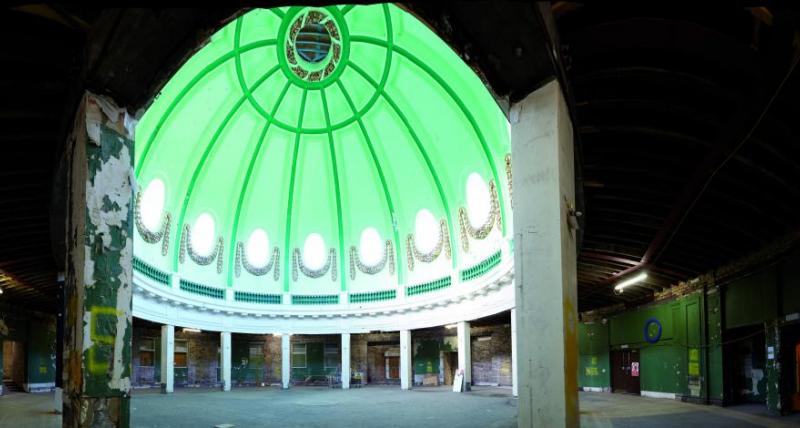
The first major milestone in the revival of the Spanish City Dome has been reached.
Work started last week to restore the iconic seafront landmark in Whitley Bay to its former glory.
The project is a key part of North Tyneside Council’s £36m Seafront Master Plan to reinvigorate the coastline between Cullercoats Bay and St Mary’s Island.
Specialist construction workers from building firm Robertson Construction have already completed the first major stage in the restoration scheme.
The first floor ceiling, which was installed shortly after the dome was first built, has now been removed, opening up double height space from the bottom to the top of the building and returning the rotunda area to its original splendour.
It means visitors will be able to look straight up and see the magnificent decorative interior view of the dome for the first time in around 100 years.
Norma Redfearn, Elected Mayor of North Tyneside, said: “It is absolutely fantastic that this first major milestone has been reached so soon after the restoration work began.
“The rotunda area is visually stunning and is even more impressive now that the ceiling has been removed and you can look straight up to the top of the building and see the dome itself. To think that people will be able to see the area in a way that hasn’t been witnessed for 100 years or so is amazing.
“I’m delighted to see the changes already taking place and this is a great example of the progress we’re making to breathe new life into our beautiful coastline and make the borough an appealing place to live, work and visit.”
The operation involved erecting scaffolding inside the ground floor before experts carefully removed sections of the wooden flooring above piece by piece to open the entire space.
Meanwhile, enabling works are well underway which will see parts of the dome’s west wing demolished. Some sections of the walls will remain to preserve as many original features as possible. Two twentieth century extensions will also be demolished as part of this first phase of works taking the façade back to how it looked around the 1920s.
Lead paint which covered the interior of the building is also being completely stripped out in order to meet safety standards, while the next stage of work will see the ageing foundations strengthened.
Since purchasing the building in 2001, the council has carried out £3m of essential structural repairs to the exterior to make it wind and water-tight.
The sympathetic restoration project involves recreating many original features which have previously been lost and adding new modern extensions at either end as well as a new rear entrance.
New construction jobs and apprenticeships will be opened up during the work as well as up to 100 employment opportunities which will be created for local people when the dome reopens. This has been made possible by the welcome financial support of the Heritage Lottery’s Heritage Enterprise Fund.
Commercial operator Kymel Trading Ltd will run the attraction as a wedding and conferencing venue featuring high-quality places to eat and drink, including a tea room, fish and chip takeaway and seafood restaurant.
The Spanish City restoration comes after North Tyneside Council successfully secured £3.47m of funding from the Heritage Lottery Fund (HLF). The council has invested £4m and also secured a Coastal Communities Fund grant of more than £2.5m.
Newcastle-based architects ADP Architecture have been appointed to carry out all architectural design services.
ENDS
Notes to editors:
About the Spanish City Dome
The Spanish City Dome is a Grade II Listed building of great national importance being an early example of the ‘Hennebique’ patented system of reinforced concrete construction. When it was built in 1910, the Spanish City Dome was the largest freestanding dome in the UK after St Paul’s Cathedral.
It became part of a modern amusement park – and was immortalised in the 1981 Dire Straits song ‘Tunnel of Love’. After the business ended, the building remained empty for five years and fell into disrepair, becoming an eyesore rather than an attraction. Following a period of decline during the 80’s and 90’s, the building closed permanently to the public in 2000.
About the Heritage Lottery Fund (HLF)
Thanks to National Lottery players, we invest money to help people across the UK explore, enjoy and protect the heritage they care about - from the archaeology under our feet to the historic parks and buildings we love, from precious memories and collections to rare wildlife.www.hlf.org.uk @heritagelottery
